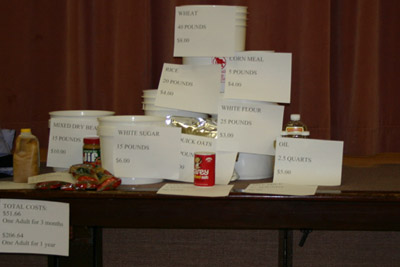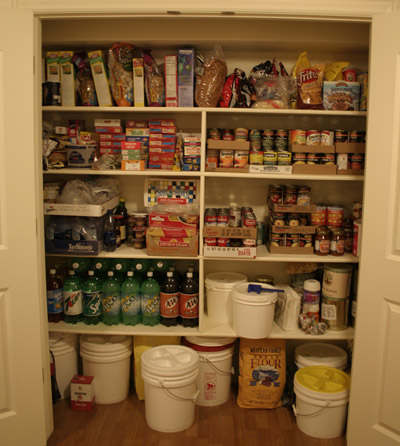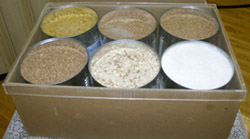|
Why Store Food?
...Acquire and store a reserve of food and supplies that will sustain life. Obtain clothing and build a savings account on a sensible, well-planned basis that can serve well in times of emergency. As long as I can remember, we have been taught to prepare for the future and to obtain a year's supply of necessities. I would guess that the years of plenty have almost universally caused us to set aside this counsel. I believe the time to disregard this counsel is over. With events in the world today, it must be considered with all seriousness. (Elder L. Tom Perry, "If Ye Are Prepared Ye Shall Not Fear," Ensign, Nov. 1995, 35
Acquire a year's supply of food. Church members can begin their home storage by storing the basic foods that would be required to keep them alive if they did not have anything else to eat. When members have stored enough of these essentials to meet the needs of their family for one year, they may decide to add other items that they are accustomed to using day to day.
Families who do not have the resources to acquire a year's supply can begin their storage by obtaining supplies to last for a few months. Members should be prudent and not panic or go to extremes in this effort. Through careful planning, most Church members can, overtime, establish both a financial reserve and a year's supply of essentials. (Letter from The First Presidency, January 20, 2002)
Storage Tips
All food contains bacteria and mold spores, and most food contains insect eggs. Given the right environment, these microorganisms will start to grow and destroy the food. The main conditions that can cause insects and microorganisms to grow are moisture and heat.
Protect food storage from heat. Store all products away from heat and sunlight. Food stores best at 70 degrees or cooler. The cooler you keep your food, the longer it will keep. Heat is a major cause of deterioration in food quality. Store all products away from heat ducts, clothes dryers, sunlight, chimneys and other sources of heat.
Protect food from moisture. Store products on shelves or raised platforms (such as 2x4 inch boards), rather than directly in contact with concrete floors or walls, to avoid moisture damage. If products are not properly packaged, they can absorb moisture out of the air. When the moisture reaches a level of 12% to 18%, product breakdown will accelerate. Make sure to store food in a dry place.
We just opened a 5 gallon bucket that was filled with packages of brown sugar and topped off with a gamma lid. We filled it up 2 and a half years ago. I thought the brown sugar may be all hard and clumpy - it was perfect, just like when we bought it from the store.
Protect products from rodents and insects.Bulk dry food storage products store well in #10 cans, foil pouches, glass canning jars, PETE (Polyethylene terephthalate) plastic bottles, and plastic buckets. Oxygen absorber packets are available to place in any kind of sealed container. They will help protect food from any undetected bugs, eggs, etc. (Do not use oxygen packs in sugars)
Basics
| How long will they last? If properly stored.
| How much do they cost? Estimates 2005
|
| Sugar | 30+ years | 25 pounds | $9 |
| Wheat | 30+ years | 50 pounds | $15 |
| Carrots | 8-10 years | #10 can | |
| Fruit Drink Mix | 8-10 years | #10 can | |
| Dry Beans (black, pink, red, lima, or kidney) | 6-8 years | 25 pounds | $15 |
| Apple Slices | 6-8 years | #10 can | |
| Spaghetti/pasta | 6-8 years | | |
| Chopped Dry Onions | 6-8 years | #10 can | |
| Hot Cocoa | 3-4 years | #10 can | |
| Rolled Oats | 4-5 years | 50 pounds | $27 |
| Vanilla/Chocolate Pudding | 5 years | #10 can | |
| White Flour | 5 years | 25 pounds | $4 |
| Soup Mix | 4-5 years | #10 can | |
| Rice, white or brown (how to cook rice) | 3-4 years | 50 pounds | $21 |
| Nonfat Dry Milk | 2-3 years | #10 can | |
| Instant Potatoes | 1-2 years | #10 can | |
| Barley | | 50 pounds | $17 |
| Refried Beans | 4-6 years | 25 pounds | $8.50 (dehydrated) |
| Baker's Milk | | 50 pounds | $47 |
|

This is an example of a 3 months supply for one adult.
| Expanded Basics
| How much do they cost?
|
| Yeasy, dry | | |
| Baking soda | | 45 cents/pound |
| Baking powder | | |
| Vanilla | | |
| Bouillon | | |
| Powdered shortning | | |
| Powdered butter/margerine | | |
| Pepper | | |
| Beef, chicken, taco, ham TVP | #10 can | $6-7 |
| Dried eggs | #10 can | $13 |
|
|

This 8 foot pantry can hold around 6 months of storage for 2 adults.
Non-food essentials
FoodStorageNow.com has a list of items such as toilet paper, feminine hygiene, medicines, toothpaste, soaps, diapers, batteries, fuels, as well as foods that you use on a day to day basis.
Kits
 One-month kits are available for purchase through the church storehouse (cannery). Kits are pre-made with supplies for 1 adult and include cans or foil bags of basic items. You'll receive: 3 wheat, 1 flour, 2 rice, 1 quick oats, 1 macaroni, 1 pinto bean, 1 sugar, and 1 milk. They also include 1 container of oil, 2 containers of salt, and 8 lids for the cans. The cost is around $30 for cans or $27 for foil pouches.
One-month kits are available for purchase through the church storehouse (cannery). Kits are pre-made with supplies for 1 adult and include cans or foil bags of basic items. You'll receive: 3 wheat, 1 flour, 2 rice, 1 quick oats, 1 macaroni, 1 pinto bean, 1 sugar, and 1 milk. They also include 1 container of oil, 2 containers of salt, and 8 lids for the cans. The cost is around $30 for cans or $27 for foil pouches.
Other
Wheat Grinders
We have three grinders (or mills):
- K-tec Kitchen Mill - electric, stainless pan, grinds fast, LOUD (we run it in the garage), works great
- Grain Maker Hand Mill - I think this is the best hand grinder you can buy. You can also drive it with a motor, bike or anything else that can turn a belt.
- Back To The Basics Hand Mill - I would only use this if it was my only option. It is better than nothing and much more affordable than the GrainMaker, but it doesn't even come close to the GrainMaker.
Websites
Water Storage
Fourteen gallons per person is a suggested minimum reserve.
55 gallon drums work well for water storage. If you plan on storing more than a few drums, you might want to consider a tank instead.
Tanks like the ones Rotational Molding of Utah
sells can save you a lot of space. In a 4' x 4' area you can store 500 gallons.
Store some water in containers that you can carry and load in your car in case you have to leave the area.
Temporary Storage
When we moved we had to put some of our food in a storage unit. You really should try to avoid it, but that isn't always an option. If you are moving to another area, check the historical weather for the months that your food will be in storage. If it is going to freeze, you'll wind up with a mess, if it gets too hot some food may go bad or have a very short shelf life.
Some people try to eat as much of their storage as they can before they move, that is one way to rotate it!
|
